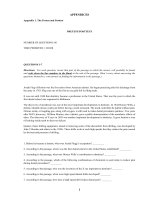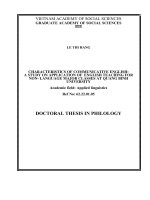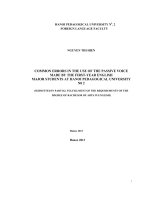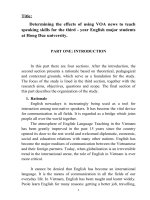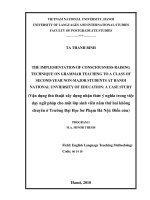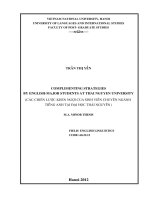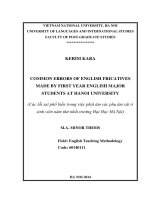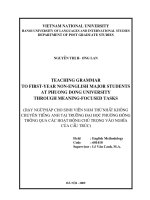How to speak english naturally for non english major students at hanoi open university
Bạn đang xem bản rút gọn của tài liệu. Xem và tải ngay bản đầy đủ của tài liệu tại đây (1.02 MB, 68 trang )
HANOI OPEN UNIVERSITY
CODE: 22
FACULTY OF ENGLISH
======o0o======
GRADUATION THESIS
B.A DEGREE IN ENGLISH STUDIES
HOW TO SPEAK ENGLISH NATURALLY FOR NON-ENGLISH
MAJOR STUDENTS AT HANOI OPEN UNIVERSITY
Supervisor
: Lê Thị Vy, M.A
Student
: Ma Lan Diệu Hương
Date of birth
: 14/12/1993
Course
: K18A1 (2011 – 2015)
Ha Noi – 2015
How to speak English naturally for non-English major students at Hanoi Open University
DECLARATION
TITLE: HOW TO SPEAK ENGLISH NATURALLY FOR
NON -ENGLISH MAJOR STUDENTS AT HANOI OPEN UNIVERSITY
(Graduation Thesis submitted in Partial Fulfillment for B.A Degree in
English)
I certify that no part of the above report has been copied or reproduced
by me from any other person’s work without acknowledgement and the report
is originally written by me under strict guidance of my supervisor.
Hanoi, 4th May 2015
Student
Ma Lan Dieu Huong
Ma Lan Diệu Hương- K18A1
Supervisor
Le Thi Vy, M.A
How to speak English naturally for non-English major students at Hanoi Open University
ACKNOWLEDGEMENT
First and foremost, I would like to express my deepest gratitude to my
supervisor, Ms. Le Thi Vy, M.A who directly instructs and gives me lots of
advice to accomplish my graduation thesis. Thanks to her valuable inspiration
and helpful guidance for the preparation as well as the correction, I can finish
this assignment on time.
I also give my sincere thanks to all my teachers in Hanoi Open
University for giving me a great deal of knowledge during the time I have
studied at the English faculty of Hanoi Open University so that I could build a
firm foundation for the implementation of this paper.
In particular, I would like to deliver my gratitude from the bottom of
my heart to my parents who always encourage, support and take care of me so
much in my whole time.
Last but not least, my special thanks send to all my dear friends who
are always willing to provide me with useful material as well as information
during my research process.
Hanoi, 4th May 2015
Ma Lan Dieu Huong
Ma Lan Diệu Hương- K18A1
How to speak English naturally for non-English major students at Hanoi Open University
TABLE OF CONTENT
PART A: INTRODUCTION ......................................................................... 1
1. Rationale……………………………………........................................... 1
2. Aims of the study……………………… ................................................. 2
3. Scope of the study ………………….. ...................................................... 2
4. Research questions………………….. ..................................................... 3
5. Methods of the study ………………........................................................ 3
6. Design of the study…………………… .................................................. 3
PART B: DEVELOPMENT .......................................................................... 5
CHAPTER 1: LITERATURE ....................................................................... 5
1.1. Speaking skills in the process of language learning ................................ 5
1.1.1. Definitions of speaking skills ......................................................... 5
1.1.2. Nature of speaking skills................................................................ 6
1.1.3. Factors affecting speaking skills .................................................... 7
1.1.4. Types of speaking skills ............................................................... 10
1.2. Overview of English speaking skills ..................................................... 12
1.2.1. English conversation ................................................................... 12
1.2.1.1. Definitions of conversation ..................................................... 12
1.2.1.2. Functions of conversation ....................................................... 14
1.2.1.3. Native speakers’ conversation ................................................ 15
1.2.2. Effective English speaking skills .................................................. 16
1.3. Summary …………………………………. ........................................... 20
CHAPTER 2: RESEARCH METHODOLOGY .......................................... 20
2.1. Method of the study.............................................................................. 20
2.1.1. Participants ................................................................................. 21
2.1.2. Research instrument .................................................................... 22
2.1.3. Design of the survey questionnaire .............................................. 22
Ma Lan Diệu Hương- K18A1
How to speak English naturally for non-English major students at Hanoi Open University
2.2. Data analysis ........................................................................................ 23
2.2.1. Students’ interest in speaking English ......................................... 23
2.2.2. Students’ attitude towards speaking skills .................................... 24
2.2.3. Students’ English self-study skills ................................................ 26
2.2.4. Students’ difficulties encounter when speaking English ............... 29
2.2.5. Students’ expectation in speaking skills ....................................... 29
2.3. The findings …………………………….. ............................................. 31
2.3.1. The lack of self-confidence .......................................................... 31
2.3.2. The limitation of vocabulary ........................................................ 32
2.3.3. The mispronunciation and misunderstanding in using grammar . 34
2.3.4. The lack of general knowledge .................................................... 36
2.3.5.Unfamiliar partner ……………………. ....................................... 37
2.3.6. The lack of motivation and flexibility in speaking English ........... 37
2.4. Summary……………………………………. ......................................... 38
CHAPTER III: SOME SOLUTIONS TO HELP NON-ENGLISH MAJOR
STUDENTS SPEAK ENGLISH NATURALLY ........................................ 38
3.1. Improve English speaking skills ........................................................... 39
3.1.1. Improve pronunciation ................................................................ 39
3.1.2. Improve vocabulary ..................................................................... 40
3.1.3. Improve speaking skills through reflective listening .................... 41
3.1.4. Improve speaking skills through reading ..................................... 42
3.2. Enrich general knowledge .................................................................... 43
3.3. Build self-confidence............................................................................ 45
3.3.1. Overcome fear of making mistakes .............................................. 45
3.3.2. Develop English speaking style ................................................... 47
3.3.3. Pay attention to physical appearance .......................................... 49
3.3.4. Prepare the topic carefully .......................................................... 49
Ma Lan Diệu Hương- K18A1
How to speak English naturally for non-English major students at Hanoi Open University
3.4. Improve group speaking ....................................................................... 49
3.4.1. Working in pairs .......................................................................... 50
3.4.2. Working in small groups .............................................................. 50
3.5. Join activities outside class ................................................................... 52
3.5.1. Join the English speaking clubs ................................................... 52
3.5.2. Communicate with native speakers .................................. ……..53
3.6. Improve English self-study skills .......................................................... 54
3.7. Summary ……………………………………… .................................... 55
PART C: CONCLUSION ........................................................................... 55
REFERENCES ............................................................................................ 57
APPENDIX 1 : SURVEY QUESTIONNAIRE ........................................... 60
APPENDIX 2: SOME USEFUL WEBSITES ............................................. 62
Ma Lan Diệu Hương- K18A1
PART A: INTRODUCTION
1. Rationale
One human characteristic is to communicate. In the modern world,
communication not only becomes the basis of social interaction, but also
improves greatly that no one of modern society can survive without
communication. A famous anthropologist, Ashley Montague (1976) says:
“The most important agency through which the child learns to be human is
communication, verbal also nonverbal”. It is essential that human being need
an instrument called “language”.
Over the past few decades, English has become the global language.
Because of global competition and industrial transformation, students must
integrate their language skills and their specialized knowledge in order to
obtain the edge in job market and stay in synchronous with the world as well.
The importance of English cannot be denied and ignored since English
becomes the most common language spoken everywhere. The number of
people around the world speaking the language is increasingly growing.
Speaking English properly opens up many opportunities. Today, language
students are considered successful if they can communicate effectively in
their second or foreign language; the accuracy of the language produced
would most likely be the major criterion contributing to the judgment of a
student’s success or lack success.
Speaking English can help learners enhance interaction in the target
language for communicating with people around the world. Along with right
methods, students can take advantage of every opportunity both within and
outside the classroom to enhance their language skills and change their career
prospects means like gaining technical knowledge, learning computer science,
etc. Therefore, it is highly essential to know that the language plays a vital
Ma Lan Diệu Hương- K18A1
1
role in our life. Mastering English seem to be one of the best and shortest
ways to have a great deal of opportunities to reach the success of life.
The topic of this study resulted from a fact that non-English major
students at Hanoi Open University often have difficulties in interacting
naturally with others in conversations. They get troubles in speaking English
even at the beginning of the conversation.
Within the minor thesis, the author attempts to clarify the difficulties in
speaking English of non-English major students at Hanoi Open University
and suggest some solutions that can help them overcome their inhibition and
develop their skills in a better way.
2. Aims of the study
The research attempts to identify the difficulties of non-English major
students at Hanoi Open University when they speak English and recommends
techniques to help them speak English naturally.
Following this trend, the study will serve these purposes:
Giving a brief overview of the previous materials relating to speaking
skills
To discuss problems of non-English major students when they speak
English
To provide solutions to help Non-English major students to speak
English naturally
To encourage and inspire non-English major students to use English
conversations effectively
3. Scope of the study
This study focuses on speaking skills, factors that influence the
conversational skills and finds out some difficulties of non-English major
Ma Lan Diệu Hương- K18A1
2
students at Hanoi Open Universities in speaking English. All the data will be
analyzed in order to find out the most effective solutions for the students.
4.
Research questions
Concisely, the research would seek the answers to the following
questions:
What is the speaking?
Why do the non-English major students have difficulty in speaking
English?
How to help non – English major students to speak English
naturally?
What techniques should be used to develop English conversational
skills for non-English major students?
5. Methods of the study
To fulfill the above aims, this study has chosen both qualitative and
quantitative methods for the study. All the considerations, remarks,
comments, suggestions and conclusions given in the study are based largely
on the analysis of statistics data. The data collection mainly focuses on:
Survey questionnaires: This method is used to find out the difficulties
in speaking English of non-English major students at Hanoi Open
University. The questionnaires are useful for getting data of the
attitudes and behaviors of learners when facing these challenges.
Interviews and observations: The methods are significant in getting
more qualitative data by getting closer to the objects of the study.
6.
Design of the study
The graduation thesis will be divided into three parts.
Part A is the introduction stating the rationale, aims, research questions,
method and design of the study.
Ma Lan Diệu Hương- K18A1
3
Part B is the development including three chapters. Chapter 1 is the
literature review. Chapter 2 is the research methodology. Chapter 3 is some
solutions to help non-English major students speak English naturally.
Part C is the conclusion of the research to summarize the main points of
the graduation paper.
Ma Lan Diệu Hương- K18A1
4
PART B: DEVELOPMENT
CHAPTER 1: LITERATURE
Speaking in a second language involves the developments of particular
types of communication skill. For most people, the ability to speak a language
is synonymous within knowing that language since speech is the most basic
means of human communication. A good speaking skill plays an important
role in helping learners make a successful conversation. This chapter deals
with speaking skills in the process of language learning and the overview of
English speaking skills.
1.1. Speaking skills in the process of language learning
1.1.1. Definitions of speaking skills
Speaking is the delivery of language through the mouth. To speak, we
create sounds using many parts of our body, including the lungs, vocal tract,
vocal chords, tongue, teeth and lips. Speaking in a second language involves
the developments of a particular type of communication skill. Most of the
non-English major students do not understand exactly “what speaking is”.
They only regard speaking as a simple, easy process by speaking out words,
ideas.
According to Harmer (1996, p.14), speaking is a form of
communication, so it is important that what you say is conveyed in the most
effective way. How you say something can be as important as what you say in
getting your meaning across.
Speaking is an activity, which is done by a person to communicate with
others in order to express ideas, feelings, as well as options to achieve a
particular goal (Philip M. Brudden. 1995, p.85)
Ma Lan Diệu Hương- K18A1
5
Chaney (1998, p.13) indicates that speaking is the process of building
and sharing meaning using verbal and non-verbal symbols, in a variety of
context.
Speaking consists of producing systematic verbal utterances to convey
meaning. Utterances are simply things people say. Speaking is “an interactive
process of constructing meaning that involves producing, receiving and
processing information”. ( Florez, M.A.C. ,1991, p. 261-277).
The book “Effective Speaking 2nd Edition” published in 1995 by Philip
M.Brudden definites that speaking is an activity that is done by a person to
communicate with others in order to express ideas, feelings, as well as
opinions to achieve a particular goal. Moreover, Tomaz P.Synalshi (1995,
p.122) provides a more comprehensive definition; defining speaking as the
activity of giving speeches and talks to indicate the opinion you are giving.
Interestingly, J.L.Kayfetz (1992, p.22) states that speaking is human verbal
communication, set out with the ability of utilizing mechanism that will
involve oral production of language. Oral production of language is the main
concern in speaking.
In general, speaking is a form of communication that human beings try
to express feelings and ideas through oral production of language. Its forms
and meanings are dependent on the context in which it occurs, including the
participants themselves, their collective experience, the physical environment
and the purpose for speaking.
1.1.2. Nature of speaking skills
It is said that foreign language differs from other subject matters such
as history or mathematics connecting much more strongly to the learners’
identity. Many researchers have pointed out that the skill producing most
anxiety is speaking (Gardner, 1991). Thus, it would seem that speaking in a
second or foreign language context is definitely not easy.
Ma Lan Diệu Hương- K18A1
6
The oral skill or speaking skill among four the macro skills (including
listening, speaking, reading, and writing) is considered one of the most
important in learning languages.
Speaking English naturally becomes a goal of speaking courses, and
requires learners to attempt real communication, despite limited proficiency in
English. Signs of fluency include a reasonably fast speed of speaking and
only a small number of pauses.
Gog and Burns (2012, p9) consider that it is essential to develop
communication strategies and engage in negotiation of meaning to improve
oral skills.
According to Bygate (1987), speaking helps learners “carry out many of
their basic transactions. It is the skill by which they are most frequently
judged, and through which they make and lose friends. It is the par excellence
of social solidarity, of social ranking, of professional advancement and of
business. It is also a medium through which much language is learnt, and for
many is particularly conductive for learning.”
For some language learners, learning to speak a language is learning
the language and their improvement in the language competence is the
progress in speaking competence. These results from the fact that listening
and speaking skills are used much more than reading and writing skills.
Speaking and listening skills are used in daily communications and learning
these skills is learning to communicate.
1.1.3. Factors affecting speaking skills
There are various factors affecting English-speaking skills. Most
students are weak in their oral ability because they are learning the language
in preparation for examinations such as final exams at the end of a term. The
items in the exams mainly focused on grammar and reading comprehension
and the students are very likely to pass the exams if they have a good
Ma Lan Diệu Hương- K18A1
7
command of grammar and reading skills. Today, both teachers and students
attach more importance to the development of speaking skills. Without
sufficient speaking skills, students are reluctant to participate actively in
classroom activities, such as discussion and role-plays.
Davis and Pearse (2000) maintain that competent use of the language is
acquired through extended exposure and realistic use of the language. In
language classroom, the way to improve speaking skills is through individual
and activities such as discussions, role-plays, and oral presentations.
Encouraging students to be actively involved in these activities seems to be
the key to the improvement of students speaking skills. However, there is a
list of factors affecting students’ speaking abilities.
• Less proficient English
Students often have difficulty understanding what the teacher says in
class and thus are unable to respond to the teacher’s questions. They
sometimes want to ask the teacher to repeat what has been but they are afraid
that others would think that their English is bad. In order not to show others
that they do not understand, they keep silent and avoid eye contact with the
teacher. As a result, the teacher is forced to assume that they are not ready for
the question. When asked to engage in some discussions on a given topic, the
students are either reticent if the teacher is not watching them.
• Students fear of mistakes and derision
Students often feel frightened at the idea of making mistakes and
negative evaluations from their peers. They avoid this by reticence and they
think they can practice the language outside the classroom by speaking
English until it is perfect. In English classroom, making mistakes is
unavoidable, and the fear of making mistakes being laughed by their
classmates may prevent many of the subjects from speaking in class.
• Unwillingness to take risks
Ma Lan Diệu Hương- K18A1
8
Guessing is considered a strategy. When students are willing to take
risks in speaking, breakdowns can be avoided and students can have greater
exposure to the target language production. Their unwillingness to take risks
hinders their ability to deal with the difficulties that arise in speaking. The
students think they will make fools of themselves by risk taking. When they
were asked, the subjects expressed their uncomfortable and helpless feelings
in dealing with the uncertainty of what they heard or how to respond. They
think the best way to avoid making fools of them is to keep silent and not join
the discussions.
According to Oxford (1999), lack of risk-taking can actually result in
seriously stunted language development, as language learning needs plenty of
practice, which is a high-risk activity. Her view is supported by Tudor (1996)
who believes that risk-taking can foster language use, and is likely to expand
the learner’s exploration of the target language and thus increase potentially
productive learning opportunities.
• Low tolerance of ambiguity
The subjects experienced discomfort and frustration in dealing with the
ambiguity of the language. As science majors, they want everything clearly
explained with rules to follow. However, there is so much vagueness about
the meanings and refresh in learning the English language; this also
contributes to their anxiety and discomfort.
Ma Lan Diệu Hương- K18A1
9
• The importance of face keeping
Less proficient English, the fear of mistakes and derision, and
unwillingness to take risks are all related to face keeping.
In oral English classes, the subjects are well aware that the risk of
making mistakes is high. They will try to avoid speaking in the presence of
their peers for fear and negative evaluation by others. In general, students
learning a foreign language feel that they are being evaluated by the teacher
and their peers.
Students who feel they lack sufficient knowledge of English to enhance
their face might react by trying to speak as little as possible or to avoid
speaking completely. As a result, their opportunities to practice the target
language are significantly reduced, which might be the reason for the
subjects’ limited progress in speaking.
• Anxiety and its effect on speaking
Speaking in front of peers and teachers is seen as the most anxietyprovoking situation of all. Anxiety has been considered a very negative factor
in learning English, especially in learning to speak the language. Speaking is
problematic because there is no preparation time for students to correct what
he or she wants to say, thus the risk of being wrong in an oral class is high.
Students with anxiety will have difficulty concentrating and processing input
in class and consequently the output of the language is negatively affected.
They tend to withdraw from voluntary participation and are unwilling to take
risks. They are apprehensive, worried and even fearful in the classroom.
When students are nervous, they tend to make more mistakes. The more
mistakes they make, the more nervous they will be, and the less likely they
are to perform well at speaking skills. Therefore, anxiety is considered a
major obstacle to developing language skills, and particularly speaking skills.
1.1.4. Types of speaking skills
Ma Lan Diệu Hương- K18A1
10
According to Robert Sanborn Brown and Paul Nation in the book
“Language teacher” published in 1997, in speaking classes, students must be
exposed to three key items.
• Form-focused speaking
Form-focused speaking considers details of pronunciation, grammar,
vocabulary, and so on. When learners first begin to speak another language,
their speaking will need to be based on some form-focused learning. It is an
effective way to learn to speak a language. It will enable the learners to
improve the language and grasp it by themselves outside the classroom.
Learners should practice some common greetings, simple personal
descriptions, and simple questions and answers. All the activities can be
practiced in repetition drills. The use of drills should be seen as one kind of
form-focused activity that needs to be balanced with other types of formfocused activities, as well as with meaning-focused and fluency development
activities. Drills play a useful part in a language course in helping learners to
be formally accurate in their speech and in helping them to learn quickly a
useful collection or phrases and sentences that allow them to start using the
language as soon as possible.
• Meaning-focused speaking
Besides form-focused speaking, language learners should also be
exposed to and given opportunities to practice and use meaning-focused
communication, in which they must both produce and listen to meaningful
oral communication.
For non-English major students, the oral speaking can be started by
giving each learner a topic. The topics could be about family, hobbies, sports,
school activities, colors, travelling and so on. Then all the learners are
required to take a topic. Having got them, each learner can think about their
topics for a minute. Before the learners speak on the topic, they can work in
Ma Lan Diệu Hương- K18A1
11
pairs or groups of three or four to repeat it. This gives the learners the chance
to learn new items from each other. The learners are given topics to talk
about. They prepare at home, using dictionaries, reference texts, reading
sources. Each learner has to choose a short and interesting article from an
English language newspaper to present to the class. The learner must not read
the article aloud to the class but must describe the main points of the article.
The class should then ask the presenter questions.
• Fluency- focused speaking
Fluency in speaking is the aim of many language learners. Signs of
fluency include a reasonably fast speed of speaking and only a small number
of pauses. These signs indicate that the speaker does not have to spend a lot of
time searching for the language terms needed to express the message. The
learners choose a topic, which they are very familiar. Then they try to explain
the topic given as fast as possible with the limited time provided.
The learners can be led to work in groups. First, they read a given text
carefully until they have reached a good understanding of it. They discuss their
understanding of the text to make sure everything is clear. Then each learner
takes turn to retell the text in their own word, and others will deliver some
questions. Then the next learners utter the tasks again in turn, like role-plays.
1.2. Overview of English speaking skills
1.2.1. English conversation
1.2.1.1. Definitions of conversation
Communication requires that all parties have a space of communicative
commonality. There are auditory means, such as speech, song, and tone of
voice, and there are nonverbal means, such as body language, sign language,
paralanguage, touch, eye contact, as well as writing.
Ma Lan Diệu Hương- K18A1
12
Communication is a process by which meaning is assigned and
conveyed in an attempt to create a shared understanding.
People sometimes use the term “conversation” to mean any spoken
encounter of interaction. Conversation refers to a time when two or more
people talk or listen without having to follow a fixed schedule. In
conversation, everyone can have something to say and everyone can speak at
anytime.
Conversation is one of the most basic and pervasive forms of human
interaction. A conversation is communication between multiple people and it
is important to most individuals. Conversations are the ideal form of
communication in some respects, since they allow people with different views
on a topic to learn from each other. A speech, on the other hand, is an oral
presentation by one person directed at a group.
There are varied definitions of conversation regarding its nature and
functions. In daily life, conversation is considered as a communicative
activity in which two or more people talk about certain topics. In classes,
some students define conversation as a form for people to talk together or
share information, ideas and feelings or it simply is a list of continual
questions and answers.
On the other hand, in some well-known books, some authors give
different views on conversation. For example, M.Bailey (2005, p.42) claims
that conversation is one of the most basic and pervasive forms of human
interaction.
Others attempts to define conversation can be seen to apply equally to
any form of dialogue. For example, Svennevig (1999,p.8) offers the definition
that “Conversation is a joint activity consisting of participatory actions
predominately in the form of spoken utterances produced successively and
Ma Lan Diệu Hương- K18A1
13
extemporaneously by different participants in alternating turns at talk which
are managed and sequentially organized”.
Conversation is interactive although one speaker is sometimes more
talkative than another, in a conversation, two or more individuals
communicate (Nunan, 2003, p.43).
Conversation consists of spoken language. Not only do the features of
spoken language but also the methods used to analyze conversation have to
consider that conversation exists within a social contact that determines the
purpose of the conversation and shapes its structure and features.
1.2.1.2. Functions of conversation
There are some ideas about the functions of conversation. Brown, G
and Yule, G (1983) state that “two different kinds of conversational
interaction can be distinguished-those in which the primary focus is on the
exchange of information and those in which the primary purpose is to
establish and maintain social relations”.
In transactional uses of conversation, the primary focus is on the
message, whereas interactional uses of conversation focus primarily on the
social needs of participants.
A conversation is designed to convey information in order to help
achieve an individual or group goal.
Small talk is a type of conversation where the topic is less important
than the social purpose of achieving bonding between people or managing
personal distance.
Banter is non-serious conversation, usually between friends, which may
rely on humor or in-jokes at the expense of those taking part. The purpose of
banter may firstly appear to be an offensive affront to the other person’s face.
However, people engaging in a conversation are often signaling that they are
Ma Lan Diệu Hương- K18A1
14
comfortable enough in each other’s company to be able to say such things
without causing offense. Banter is particularly difficult for those on the autism
spectrum, or those will semantic pragmatic disorder.
1.2.1.3. Native speakers’ conversation
True conversation is unscripted, free-ranging discourses involving two
or more people. In conversation, the topic can exchange and the individual
take turns, that is the utterances build on the different speaker’s contribution.
Finding out the way of native speakers form a conversation seems to be
one of the best ways to make conversations successfully in English. Basing on
some information cited from Nolasco and Arthur (2007, p.7), a normal
conversation could follow these rules:
• Usually only one speaker speaks at a time
• The speakers change
• The length of the any contribution varies
• There are techniques for allowing the other party or parties to speak
• Neither the content nor the amount of what we say is specified in
advance
The majority of conversations can be divided into four categories
according to their major subject content:
• Conversations about subjective ideas, which often serve to extend
understanding and awareness.
• Conversations about objectives facts, which may serve to
consolidate a widely-held view.
• Conversations about other people (usually absent), which may be
critical, competitive, or supportive. This includes gossip.
• Conversations about oneself, which sometimes indicate attentionseeking behaviors.
Ma Lan Diệu Hương- K18A1
15
1.2.2. Effective English speaking skills
Effective English speaking skills is important in various spheres of life.
It helps people understandings and connecting with others. This fulfils the
human need for socializing. It is “the process of transferring information from
a sender to a receiver with the use of a medium in which the communicated
information is understood by both sender and receiver.” (“Communication”
Wikipedia)
An effective speaking activity is characterized by some main points
below:
• The content and vocabulary
For a successful conversation, the partners must achieve a workable
balance of contributions. A successful conversation includes mutually
interesting connections between the speakers that the speakers know. For this
to happen, those engaging in conversation must find a topic on which they
both can relate to in some sense. Those engaging in conversation naturally
tend to relate the speakers’s statement to themselves. They may insert aspects
of their lives into their replies, to relate to the other person’s opinions or
points of conversation.
The speaker should know each and everything on the subject chosen to
talk about. All things he/she speaks must clearly reflect his/her clarity of
thought on the subject concerned. A particular subject should also be clear to
the speaker. Lack of clarity in this regard makes the listener confused and
disinterested in listening to the speaker. The content of the talk should be
useful and interesting to keep alive the listener’s interest throughout the
interaction. The listener should find it both interesting and personality useful
to remain alternative to what the speaker says.
Before speaking on the subject, a speaker is expected to acquaint
himself/herself with various dimensions of the subject thoroughly to do full
Ma Lan Diệu Hương- K18A1
16
justice to his/her speech. And then, they depend on the need, interest and level
of understanding of the listeners.
A conversation often depends on questions to keep it going in the
direction you want it to go. The one who asks the questions in a conversation
usually controls the conversation.
A conversation keeps going as long as the listener continues to show
interest in what the speaker says and responds to it intelligently. However, no
sooner does the listener indicate a lack of interest in what the speaker is
talking about than the interaction gets terminated immediately.
Most of the time, people communicate orally for a variety of reasons
from serious purposes like asking some favors for fulfillment of some daily
needs such as physical, mental, emotional and spiritual or sharing some
moments of joy, and happiness with others.
It is believed that a person who chooses to cover a vast area of the
subject under discussion is a better speaker than the one who restricts oneself
only to a limited are. The speaker should present the content in a logical,
cohesive and interesting manner. Besides, the speaker should know what to
say and how to say on a subject to be able to speak effectively. Both speaker
and listener should express themselves in utterances that are relevant, easily
comprehensible to each other, and of an acceptable level of language
accuracy.
Using the right words all the right place seems to be one of the best
ways to leave a permanent impact on the listener’s mind. Therefore, it is
essential for speaker to enrich a good active vocabulary. The ability to use
every word as different parts of speech will further enable him/her to
communicate on the subject concerned effectively. In the absence of
appropriate usage of words, a speaker fails to communicate exactly what that
particular situation demands.
Ma Lan Diệu Hương- K18A1
17
It is a proven fact that only the thoughts presented in a logical and
cohesive way leave a permanent impact on the listener’s minds. Besides, the
speaker should pays attention to the listener who is the most important partner
in the interaction.
• The knowledge of phonetic
It is said that knowledge of phonetics and phonetic symbols
representing various vowel and consonant sounds is essential to be able to
speak effectively. “Studying the rules of pronunciation and the Phonetic
Alphabet is the key to speak English well” (Dennis, 2011, p.5).
The knowledge of phonetic symbols is quite helpful in understanding
the sound system of English language.
In fact, producing the correct sound of an alphabet in usage even
without knowing the internationally recommend phonetic symbols for it.
Phonetics does not mean the knowledge of phonetic symbols alone, but is the
study of the speech sounds.
“It is difficult to connect English spelling with pronunciation, the
guidelines for pronunciation is to base on the International standard as
accepted by the Oxford dictionary. All signs and symbols used for explaining
pronunciation conform to International Phonetic Alphabet” (Vaid, 2008,
p.170). The International Phonetic Alphabet (IPA) is a collection of symbols
that represent the different sounds of a language. “Many of the symbols in the
phonetic alphabet are the same as the symbols you use in the regular spelling
alphabet, so you are not getting into totally unfamiliar territory. Some are
new symbols, but they are not difficult to learn” (Geoffrey, 2001, p.82).
The wonderful thing about the phonetic alphabet is that it has only one
symbol for each speech sound and only one speech sound for each symbol.
This makes it very easy to identify the sound you are saying or want to say.
You will have very little trouble learning the exact sounds and symbols of the
Ma Lan Diệu Hương- K18A1
18
phonetic alphabet. If you speak English, you already say the speech sounds
with some degree of accuracy. You just need to become aware of how you
create the sound. When you know all the sounds of English and the symbols
that represent those sounds, you will be able to pronounce any word in
English.
• Stress and intonation
Word stress is your magic key to understanding spoken English. To
understand word stress, it helps to understand syllables. Every word is made
from syllables. Each word has one, two, three or more syllables. It is part of
the language. English speakers use word stress to communicate rapidly and
accurately, even in difficult conditions. For example, if you do not hear a
word clearly, you can still understand the word because of the position of the
stress. A talk delivered with right stress is like a musical treat to its listeners,
which they want to listen.
Intonation is categorized as a component of phonology in English,
discussion on what intonation is can be found in a number of influential
works of leading phoneticians. In the book “The Communication Value of
Intonation in English” published in 1997 of Eenest G. Bormann produces
“the effect of prominence on syllables that need to be perceived as stressed,
and in particular the placing of tonic stress on a particular syllable marks out
the word to which it belongs as the most important in the tone unit”. This idea
can be understood that intonation is used to bring some parts of the message
into focus, and leave other parts out of focus, to emphasize some parts and not
others.
In terms of grammar, intonation helps the listener recognize the
grammar and syntactic structure of the utterance. For instance, intonation is
used to mark the beginning and end of grammatical units such as clause and
sentence; or it can be used to distinguish clause types, such as question vs.
statement, and to disambiguate the ambiguity.
Ma Lan Diệu Hương- K18A1
19
